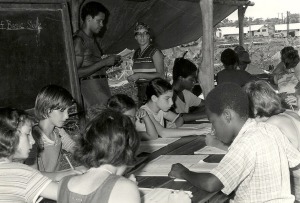With my background in journalism and communications, I have always been intrigued by the influence of media and culture on our thinking and the ways we communicate that thinking, or, put another way, how we send and receive messages about ourselves. From religion to race, politics and personal values, the story of Peoples Temple represents the intersection of aspects of society that hugely influence our thinking. As such, I think that critical analysis of Peoples Temple affords us the opportunity to examine not only Jonestown but ourselves as well.

I had been teaching a critical thinking course for some time when I first viewed the PBS documentary, Jonestown: The Life and Death of Peoples Temple. At that time, I possessed a superficial familiarity with the story of Jonestown and Peoples Temple, but the film left me captivated. As I watched, I saw many of the critical thinking concepts that I had been teaching on display. I did not see the collection of mindless cult followers who committed mass suicide that is often conjured by fleeting mentions in mainstream media. The film presented Peoples Temple in a manner that beckoned me to learn more about the people who had been part of it. After further researching Peoples Temple, I decided to show the documentary in my course. Admittedly, I hoped that viewing it within the context of the course might elicit a similar response from my students.
We used the book Thinking Critically by John Chaffee in my course. Chaffee posits that the major influences on thinking are people, knowledge, and experiences. Because of my background, I add media as another major influence. As part of the foundation for understanding the text, we discussed the influence of values, morals, and ethics on thinking as well. To consider how beliefs dictate behavior, it is important for students to examine how individual values shared by a group form morals that establish the ethics that eventually govern the group. I think understanding this relationship provides an excellent backdrop for analyzing Peoples Temple.
We spent a significant amount of time studying what Chaffee identifies as the three stages of knowing. In the first, The Garden of Eden, knowledge is provided by authorities, such as parents, teachers, clergy, etc. At this stage the word of the authority is accepted as truth and not questioned. The thinker questions authority and acknowledges differences of opinion in the second stage of Anything Goes, but still refrains from evaluation and decision making. Only in the third stage, Thinking Critically, do thinkers use evidence to analyze, question, and evaluate opinions so that they can make informed decisions about what is true. We also discussed Chaffee’s 10 qualities of critical thinkers, which includes being knowledgeable, open-minded, creative, self-aware, and passionate.
I introduced the Peoples Temple assignment at the midpoint of the course after students had demonstrated a firm grasp of Chaffee’s theories and the ability to effectively apply them. For the assignment, I paired the documentary with questions for further analysis and discussion. The questions I developed centered on the values of Peoples Temple members, their thinking, and influences on their thinking. I also asked students to share their perceptions of Peoples Temple along with the beliefs that influenced them.
Prior to viewing the documentary, my classes of largely Christian, urban 20-somethings had little knowledge of Jim Jones beyond the lingering Kool-Aid reference and a rapper who shares his name. Their lack of knowledge reflected how far away from the public psyche the story of Peoples Temple has been stowed, which itself is a reflection of American media and culture that merits critical analysis. However, it did present a blank palette on which my students could apply Chaffee’s critical thinking theories, or so I thought.
What I found was that, regardless of the students’ understanding of Chaffee’s theories, their perceptions of Peoples Temple were overwhelmingly negative. A visible layer of implicit bias veiled their responses. At times my students essentially dehumanized Peoples Temple members in an attempt to dismiss any analysis of the values they possibly shared with them. An air of discomfort was present whenever we discussed similarities between Peoples Temple and their own churches or churches in general. Irrespective of the aspect of critical thinking that we discussed, my students regularly erected barriers to separate themselves from the members of Peoples Temple.
Few students thought any Peoples Temple members were critical thinkers. On the contrary, the class overwhelmingly rejected the notion that any of the members’ decisions could have resulted from critical thought. They routinely eschewed Chaffee’s theories and terms, opting to describe Peoples Temple members as “brainwashed,” “stupid,” or “crazy.” Most students seemed averse to acknowledging anything positive about Peoples Temple. It was as if they believed that doing so would reflect negatively on them. One student who referred to Jonestown as “revolutionary” was nearly ridiculed. Despite having a solid critical thinking framework for analyzing Peoples Temple and Jonestown, my students had a difficult time applying it. They even struggled to identify the beliefs that influenced their own perceptions.
The assignment proved a more difficult task than I envisioned. I have used it in multiple critical thinking classes with little variation in student response. My experience teaching Jonestown unearthed for me the depth of introspection that is required to think critically about Peoples Temple. Perhaps my first-year students were too uncomfortable, unwilling or unable to attempt that level of introspection. Perhaps on some level we all are.
Works Cited
Chaffee, John. Thinking Critically. Cengage Learning, 2011.
(Kamilah Cummings is currently a member of the resident writing faculty at DePaul University School for New Learning in Chicago, IL. She previously taught the critical thinking course at Westwood College’s Chicago Loop campus from 2008 – 2012 where she was a member of the full-time writing and communications faculty there. She can be reached at cummingskamilah@gmail.com.)